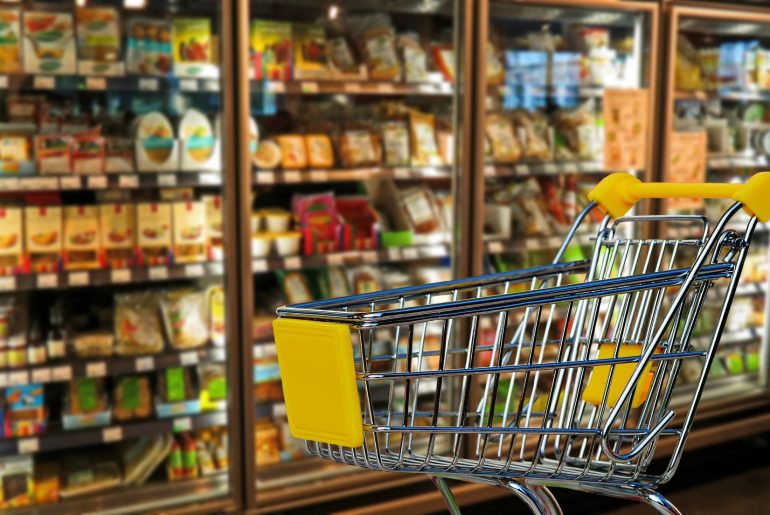Have you ever gone into the grocery store looking for one or two items and ended up leaving way over budget? You have forces working against you beyond your own cravings. It turns out, supermarkets have plenty of tricks and strategies they use to get the most money out of every consumer visit.
According to the Food Marketing Institute, the typical supermarket sells about 40,000 different products. Moving all these fresh foods and packaged goods along before they hit expiration is imperative to the store’s success, so they don’t leave their sales simply up to chance. The layout of the store is very specific, from the fresh flowers and produce up front to the dairy in the back and packaged goods in the center aisles, everything is where it is for a reason.
The best ways to avoid letting the supermarket get the best of you is to make a grocery list, stick to it, and never allow yourself to shop hungry. And remember these 1 tricks every grocery stores uses to try to separate you from your hard earned cash.

Shopping carts aren’t just for your benefit
The first shopping cart was invented in 1938, and the thought was that it would encourage shoppers to spend more. Since then, the standard shopping cart has tripled in size. One experiment found that when the shopping cart was double in size consumers on average bought 40 percent more. Stores across America have been experimenting with larger cart sizes and manufacturers have been expanding their offerings. Whole Foods’ doubled their cart sizes between 2009 and 2011.
High-margin entryway
People usually only go into grocery stores expecting to spend some money, and the best time to hit you with high-margin items is when you first walk in. This is why you’ll find the fresh-cut flowers, baked goods, rotisserie chicken and ready-made meals at the front of the store.
Colorful fruits and veggies
Supermarket shopping experts know that if you see bright splashes of color from produce when you first walk in, you’ll be in a better spending mood — which also translates into a spending money mood.
Misting Mistakes
About 80 percent of supermarkets now mist their produce because they know shoppers associate the wet look with freshness and cleanliness. But in reality, the added spray doesn’t actually do anything positive for most fruits and veggies. It can actually make them rot faster and will add extra weight that you’ll have to pay for.
Long Aisles
The length of the aisle is usually only restricted by the size of the store. Almost all supermarkets set up very long, straight, parallel aisles that force shoppers to walk the entire aisle before turning around and doing going the opposite direction — over and over and over. This forces you to pass by more items than you otherwise might and keeps you in the store for longer.
Essentials banished to the back
If you’re just popping into a supermarket for one or two items, chances are they’re in the back. Milk, eggs, cheese. Many of these items are in the back because refrigeration trucks can pull right up and unload, decreasing the time the items are exposed to warmer temperatures. But it also serves another purpose. Supermarkets know you’ll have to walk those long aisles to reach these everyday essentials, and you’ll probably pop a few other items in your cart along the way.
Endcap optimization
Endcaps, the space at the end of each aisle, are prime real estate for impulse buys because you’re more likely to see items here than in the middle of the aisle. For this reason, brands fight over who gets to use this sweet spot. Beer, snacks, pizza and pop are likely to land in this high-traffic territory.
99 cent theory
Pricing a product with tag ending in 99 cents makes consumers automatically round down to the dollar. For an item that’s $2.99, the theory says that consumers will always look to the $2 rather than round up to $3, and this encourages more sales as consumers thing they’re getting the product for much less.
Down with the Dollar sign
Researchers at Cornell University found in an on-campus experiment, that people tended to spend more when dollar signs weren’t placed before the numerals in the price of a good. In other words, shoppers shelled out more money when the item was listed at “5.00” rather than “$5.00.”
slow jams
Nothing is left to chance. Even the music is strategically chosen to keep customers relaxed. Oldies and more modern generally pleasant tunes are the preferred shopping soundtracks. That’s because these types of songs can make you feel happy and cause you to graze the shelves more slowly, spending more time and more money in the store.
Checkout line temptation
If you’ve entered the grocery store hungry, forget about it. You’ve likely already overfilled your cart with fattening food you wish you were eating right now. But in the checkout like you’ll actually encounter snacks that you can open immediately. Supermarket owners know you’ll be forced to stare at these tempting treats, shiny magazines and quirky gadgets as you wait in line to check-out, and they know your best judgement won’t always win.
Tight Checkout lines
If you’ve ever felt the checkout lines are a little narrow for your liking, that’s on purpose. It’s at this point some people decide they don’t want an item. Rather than give you room to put it down, supermarkets make it very difficult so you hopefully just decide to buy it instead of wedging it between the chapstick and chewing gum.
Also see, Women no longer primary grocery store shoppers.




